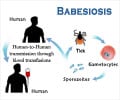A human-infecting parasite has developed sterile soldiers, mirroring the behavior of ants and termites, to safeguard its colonies.

The physical soldier caste of an invasive, human-infecting flatworm is morphologically extreme and obligately sterile
Go to source). The discovery, published today in the Proceedings of the National Academy of Sciences and funded by the National Institutes of Health, vaults this species of parasitic flatworm into the ranks of complex animal societies such as ants, bees and termites, which also have distinct classes of workers and soldiers that have given up reproduction to serve their colony.
‘A human-infecting #parasite employs sterile soldiers, similar to ants and termites, to protect its colonies. These sterile defenders play a crucial role in the colony’s survival despite their inability to reproduce.’





Haplorchis pumilio: Flatworm Risks, Prevention, and Global Impact on Foodborne Infections
When it gets into humans, usually via the consumption of raw or undercooked fish, this species of flatworm, Haplorchis pumilio, can cause gastrointestinal issues and in severe casesUnlike bees and termites, the colonies of this species of flatworm are not underground or in a tree hollow, but inside the body of a live snail. The parasites don’t kill the snail, but instead siphon off nutrients for years as they pump out free-swimming clones that search for fish, the flatworms’ next host in their complex life cycle.
“Compared to bees or termites, you can fit way more colonies from these flatworms in the lab,” said Ryan Hechinger, an ecologist at Scripps and the study’s senior author. “These flatworms could become invaluable tools to probe fundamental questions of sociobiology – like, ‘how does this kind of social organization evolve?’”
While some other species in this class of parasitic flatworms, called trematodes, also have soldiers, those species’ soldiers may still contain some inactive reproductive tissue, suggesting they can become reproductive at some point. This study is the first evidence for trematode soldiers that are so physically specialized to their task that they lack any reproductive tissues and appear permanently incapable of reproduction, said Hechinger.
Haplorchis pumilio forms nest-like colonies inside the freshwater snail Melanoides tuberculata and then infects two other successive hosts during its life cycle – typically fish and finally a warm-blooded vertebrate. Both the trematode and the snail are native to Africa and southern Asia but are co-invasive in the Americas, including California, Texas and Florida.
Advertisement
“These worms want to guard their house,” said Dan Metz, the paper’s lead author and a postdoctoral researcher at the University of Nebraska-Lincoln who conducted this study during his PhD at Scripps. “Another parasite infecting their snail is like someone coming into your home and threatening your family. You’ll do what you can to protect your family, and so will these worms.”
Advertisement
Upon taking a closer look at the colony of parasites, Metz and Hechinger noticed that many members of the colony were about half as long and differently proportioned than the rest. These smaller worms turned out to be the soldiers, which, despite being less than half a millimeter long (0.02 inches), had mouths five-times larger than those of their much larger, reproductively capable counterparts.
“These soldiers are really just mobile jaws,” said Metz. “Their whole function is to bite things.”
Through experiments and close examination, Metz and Hechinger uncovered multiple lines of evidence that suggest these soldiers are totally different from their reproductively capable kin inside the colony.
First, all the soldiers lacked any reproductive organs, while even the most immature reproductive worms – including unborn ones still inside their parent – had detectable reproductive structures. Second, the researchers did not encounter any worms that had body proportions that appeared to bridge the physical gap between soldiers and the reproductive worms. Soldiers of all sizes had relatively massive maws compared to their overall body size while no reproductive worms approached the soldiers’ mouth-centric proportions. And third, the researchers showed through experimental trials that soldiers consistently attacked other parasites, while reproductive worms showed almost no aggressive behavior.
The study also showed that having dedicated soldiers appears to facilitate ecological dominance for this trematode species, at least in its invasive range in Southern California. Among other species of trematodes that have also invaded Southern California and that infect the same snail, the researchers calculated that the soldier-producing species caused around 94% of all of the deaths that occurred among the different species. This superior firepower in trematode conflict led the abundances of the other trematode species to be much lower than they would otherwise be.
“The soldiers don’t infect humans – they are only in the snails,” said Metz. “A different stage in the worm’s life cycle infects warm-blooded vertebrates, including people, but having soldiers makes this parasite more successful at infecting snails, which means more opportunities to transmit to people.”
This parasite is spreading globally and understanding its biology could be important for public health as well as for understanding the evolutionary roots of complex social organization. There may also be many more species of trematodes with permanent soldier castes.
“We’ve really barely started looking,” said Hechinger. “There may be up to 200,000 species of trematode on the planet, and we’ve only looked at a few of them in the context of social organization. There is a lot more waiting to be discovered concerning the ways by which trematodes create complex societies with division of labor.”
Reference:
- The physical soldier caste of an invasive, human-infecting flatworm is morphologically extreme and obligately sterile - (https://www.pnas.org/doi/10.1073/pnas.2400953121)
Source-Eurekalert












